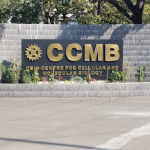CSIR - Centre for Cellular & Molecular Biology
Council of Scientific and Industrial Research
The Innovation Engine of India
Date : August 30, 2024

Cells in our body communicate with their surroundings through tiny nanomachines called G protein-coupled receptors (GPCRs) that are embedded in the outermost membrane which wraps the cell. Owing to their crucial role in maintaining key cellular processes, these receptors have emerged as major drug targets in almost all clinical areas.
The serotonin1A receptor is one such important GPCR that is involved in neurotransmission and is an important drug target in neuropsychiatric disorders such as anxiety and depression. The function of GPCRs such as the serotonin1A receptor is regulated by their internalization into the inside of a cell through a process called endocytosis – a key event in the therapeutic action of several drugs that act via GPCRs. Prof. Amitabha Chattopadhyay’s group from the CSIR-Centre for Cellular and Molecular Biology (CCMB), Hyderabadhad previously shown that the serotonin1A receptor internalizes into cells through specialized regions of the cell membrane, called clathrin-coated pits, and thereafter recycles back to the cell membrane.
In a follow-up discovery published in the American Chemical Society journal, ACS Chemical Neuroscience, Prof. Chattopadhyay’s group has now shown that modulating the levels of cholesterol, an important lipid in the cell membrane, could modulate the mechanism of endocytosis of the serotonin1A receptor. When the researchers from CCMB treated cells with statin, the best-selling cholesterol lowering drug in the market, they observed that the serotonin1A receptor, instead of using clathrin-coated pits, internalized through alternate regions called caveolae, which are cave-like structures on the cell membrane. “We observed that this switch in the mechanism of internalization again reverted back to clathrin-coated pits when we put back cholesterol in cells that was lost upon statin treatment”, said G. Aditya Kumar, a Ph.D. student who is the first author of the paper
Interestingly, experiments from the team also revealed that receptors that usually recycle back to the cell membrane in normal conditions started getting degraded inside cells when they were treated with statin. “We believe that our findings arecrucial in understanding how cholesterol in cell membranes modulatesthe endocytosis of GPCRs”, explains Prof. Chattopadhyay. An important class of antidepressant drugs, termed selective serotonin reuptake inhibitors (SSRIs), target the endocytosis of the serotonin1A receptor as their mechanism of action. “From a biomedical standpoint, these results could provide novel insights into the mechanism underlying recent reports on the improved therapeutic activity of antidepressant drugs when administered in combination with statins”, Prof. Chattopadhyay added. These studies from CCMB are especially relevant in the Indian context since the National Mental Health Survey (2015-16) reported that more than 5% of the adult Indian population suffers from depression.
Kumar, G.A., and Chattopadhyay, A. (2020) “Statin-Induced Chronic Cholesterol Depletion Switches GPCREndocytosis and Trafficking: Insights from the Serotonin1A Receptor” ACS Chem. Neurosci. 11: 453-465 (DOI: 10.1021/acschemneuro.9b00659).
 Advertisement no 07/10 for the post Junior Scientist.
Advertisement no 07/10 for the post Junior Scientist.
 List of shortlisted candidates for the temporary positions against CCMB Web Notif.No.0724/B- [26-08-2024]
List of shortlisted candidates for the temporary positions against CCMB Web Notif.No.0724/B- [26-08-2024]
 Result of selected candidates for the temporary positions against CCMB Web Notif.No.0724/A - [21-08-2024]
Result of selected candidates for the temporary positions against CCMB Web Notif.No.0724/A - [21-08-2024]
 Notification of Schedule for Trade Test and Downloading of Admit Cards for the posts of Gr. II (1)/Technician (1) against Advt.No:01/2021 - [19-08-2024]
Notification of Schedule for Trade Test and Downloading of Admit Cards for the posts of Gr. II (1)/Technician (1) against Advt.No:01/2021 - [19-08-2024]
 List of selected candidates for the temporary positions against CCMB Web Notif.No.0624/A - [14-08-2024]
List of selected candidates for the temporary positions against CCMB Web Notif.No.0624/A - [14-08-2024]
 List of shortlisted candidates for the temporary positions against CCMB Web Notif.No.0724/A - [02-08-2024]
List of shortlisted candidates for the temporary positions against CCMB Web Notif.No.0724/A - [02-08-2024]
 Notification No.0824/A for various temporary positions on contractual basis- [02-08-2024]
Notification No.0824/A for various temporary positions on contractual basis- [02-08-2024]
 Notification No.0724/B for various temporary positions on contractual basis - [29-07-2024]
Notification No.0724/B for various temporary positions on contractual basis - [29-07-2024]
 List of shortlisted candidates for the temporary positions against CCMB Web Notif.No.0624/A- [19-07-2024]
List of shortlisted candidates for the temporary positions against CCMB Web Notif.No.0624/A- [19-07-2024]
 List of Provisionally empanelled candidates for Engagement as Project staff Vide Notif.No.2024/1 - [15-07-2024]
List of Provisionally empanelled candidates for Engagement as Project staff Vide Notif.No.2024/1 - [15-07-2024]